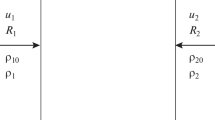The authors have described a change in the spatial dispersity distribution of a powder gas suspension on a z-shaped classifier of particles. The process of separation of particles by size occurs under the gravity force and the aerodynamic resistance force and is described by the Eulerian model of a polydisperse gas suspension consisting of several fractions of particles of varying radius and of air as the carrier medium. The dynamics of dispersed fractions is described by systems of equations of the gasdynamic type with account of the interphase exchange of momentum and energy with the carrier medium whose motion is described by a system of Navier–Stokes equations which takes account of the exchange of momentum and energy with the dispersed fractions. The system of equations of a polydisperse gas suspension is represented in generalized curvilinear coordinates and is solved by the explicit predictor–corrector method with splitting of the spatial operator by directions and with the scheme of nonlinear correction at each time step. Consideration has been given to the time and space characteristics of the process of motion of the carrier medium and the dispersed fractions.
Similar content being viewed by others
References
W. Strauss, Industrial Gas Cleaning [Russian translation], Khimiya, Moscow (1981).
M. Shapiro and V. Galperin, Air classification of solid particles: A review, in: Chemical Engineering and Processing: Process Intensification, Elsevier (2005), pp. 279–285.
V. Zinurov, A. Dmitriev, and V. Kharkov, Influence of process parameters on capturing efficiency of rectangular separator, Int. Conf. on Information Technology and Nanotechnology (ITNT), Russia, Samara, 2020, pp. 1–4; DOI: https://doi.org/10.1109/ITNT49337.2020.9253320.
V. Banjac, L. Pezo, M. Pezo, et al. Optimization of the classification process in the zigzag air classifier for obtaining a high protein sunflower meal. Chemometric and CFD approach, Adv. Powder Technol. (2017); https://doi.org/10.1016/j.apt.2017.01.013.
A. N. Osiptsov, Lagrangian approach to the mechanics of dispersive media: Advantages and prospects, Vestn. Nizhegor. Univ. im. N. I. Lobachevskogo, No. 4 (3), 1024–1026 (2011).
M. A. Pakhomov and V. I. Terekhov, Propagation of solid particles in a gas-dispersed confined swirling flow. Eulerian and Lagrangian descriptions, Teplofiz. Aéromekh., No. 3, 335–348 (1017).
A. V. Fedorov, D. A. Tropin, and A. V. Panov, Numerical and analytical modeling of one gas-suspension problem, J. Eng. Phys. Thermophys., 92, No. 2, 414–423 (2019).
A. G. Kutushev, Mathematical Modeling of Wave Processes in Aerodispersed and Powder Media [in Russian], St. Petersburg, Nedra (2003).
A. L. Tukmakov, V. G. Tonkonog, and N. A. Tukmakova, Hydro- and thermodynamics of a polydisperse vapor–droplet mixture in the channel of a heater regasifier of liquefied natural gas, Teplofiz. Aéromekh., 27, No. 2, 281–296 (2020).
J. L. Steger, Implicit finite-difference simulation of flow about arbitrary two-dimensional geometries, AIAA J., 16, No. 7, 679-686 (1978).
C. A. J. Fletcher, Computational Techniques for Fluid Dynamics, Vol. 2 [Russian translation], Mir, Moscow (1991).
V. M. Kovenya, G. A. Tarnavskii, and S. G. Chernyi, Employment of the Splitting Method in Aerodynamics Problems [in Russian], Nauka, Sib. Otd., Novosibirsk (1990).
I. F. Muzafarov and S. V. Utyuzhnikov, Application of compact difference schemes to investigation of nonstationary flows of compressible gas, Mat. Modelir., 5, No. 3, 74–83 (1993).
O. Florea and O. Smagel’skii, Calculations on Processes and Apparatuses of Chemical Engineering [Russian translation], Khimiya, Moscow (1971).
G. S. Gorelik, Vibrations and Waves. An Introduction to Acoustics, Radio Physics, and Optics [in Russian], Fizmatlit, Moscow (1959).
Author information
Authors and Affiliations
Corresponding author
Additional information
Translated from Inzhenerno-Fizicheskii Zhurnal, Vol. 95, No. 4, pp. 918–924, July–August, 2022.
Rights and permissions
Springer Nature or its licensor holds exclusive rights to this article under a publishing agreement with the author(s) or other rightsholder(s); author self-archiving of the accepted manuscript version of this article is solely governed by the terms of such publishing agreement and applicable law.
About this article
Cite this article
Tukmakov, A.L., Khar’kov, V.V. & Akhunov, A.A. Pneumatic Separation of Fractions of a Polydisperse Gas Suspension in a Low-Velocity Flow. J Eng Phys Thermophy 95, 902–908 (2022). https://doi.org/10.1007/s10891-022-02549-0
Received:
Published:
Issue Date:
DOI: https://doi.org/10.1007/s10891-022-02549-0



